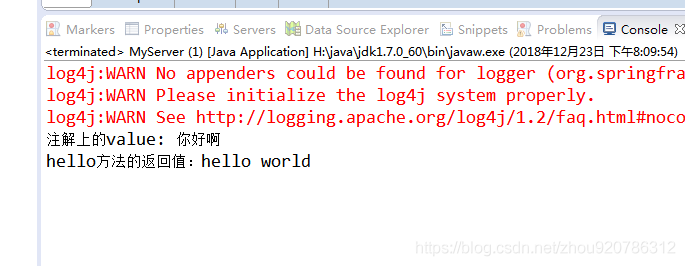spring自定義註解的簡單使用案例+ApplicationContextAware介面的使用
阿新 • • 發佈:2019-01-06
程式碼
註解 @Target({ ElementType.TYPE })//註解用在介面上 @Retention(RetentionPolicy.RUNTIME)//VM將在執行期也保留註釋,因此可以通過反射機制讀取註解的資訊 @Component public @interface RpcService { String value(); } ----- 使用註解 public interface HelloService { String hello(String name); } @RpcService("你好啊") public class HelloServiceImpl implements HelloService { public String hello(String name) { return name; } }
測試類
@Component //ApplicationContextAware會為Component元件呼叫setApplicationContext方法; 測試Myserver3時註釋 public class Test implements ApplicationContextAware { @SuppressWarnings("resource") public static void main(String[] args) { ClassPathXmlApplicationContext ctx = new ClassPathXmlApplicationContext("spring2.xml"); } public void setApplicationContext(ApplicationContext ctx)throws BeansException { //獲取被註解標準的bean Map<String, Object> serviceBeanMap = ctx.getBeansWithAnnotation(RpcService.class); for (Object serviceBean : serviceBeanMap.values()) { try { //獲取自定義註解上的value String value = serviceBean.getClass().getAnnotation(RpcService.class).value(); System.out.println("註解上的value: " + value); //反射被註解類,並呼叫指定方法 Method method = serviceBean.getClass().getMethod("hello",new Class[] { String.class }); Object invoke = method.invoke(serviceBean, "hello world"); System.out.println("hello方法的返回值:"+invoke.toString()); } catch (Exception e) { e.printStackTrace(); } } } }
配置和專案截圖

結果:

